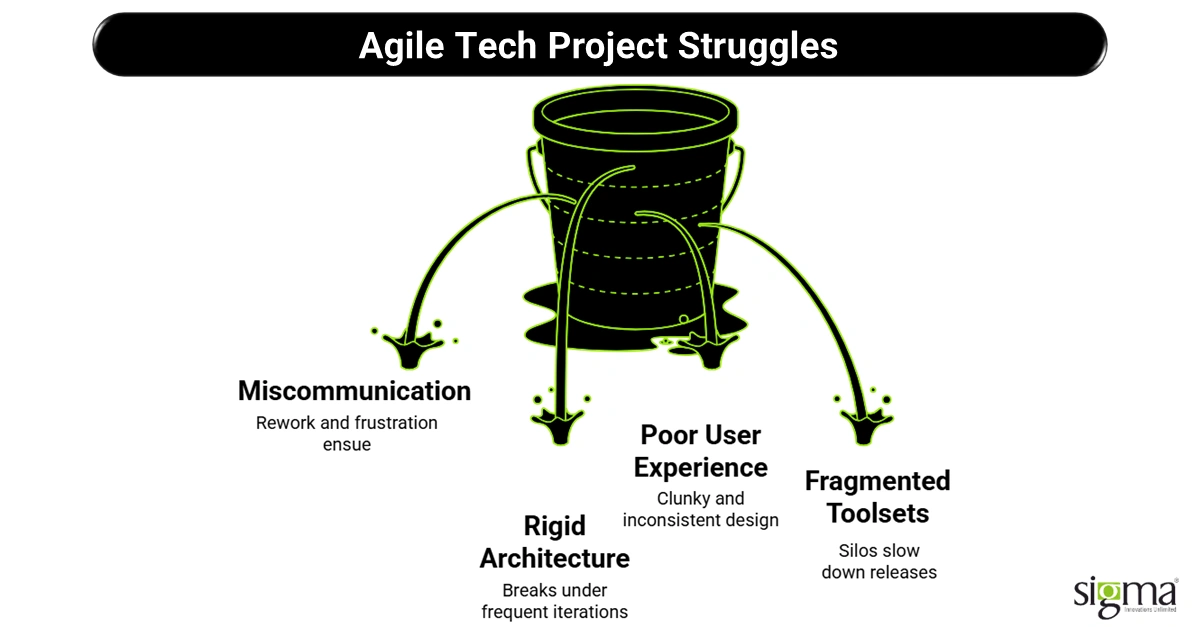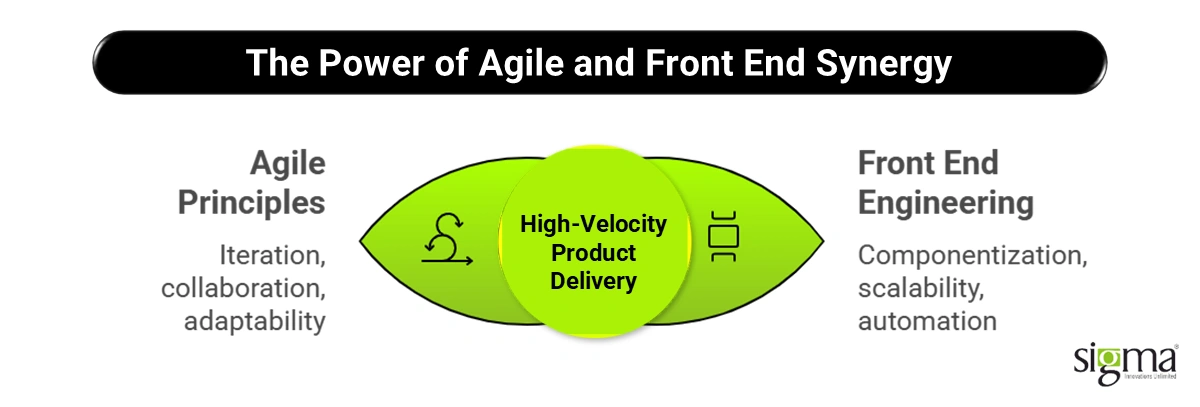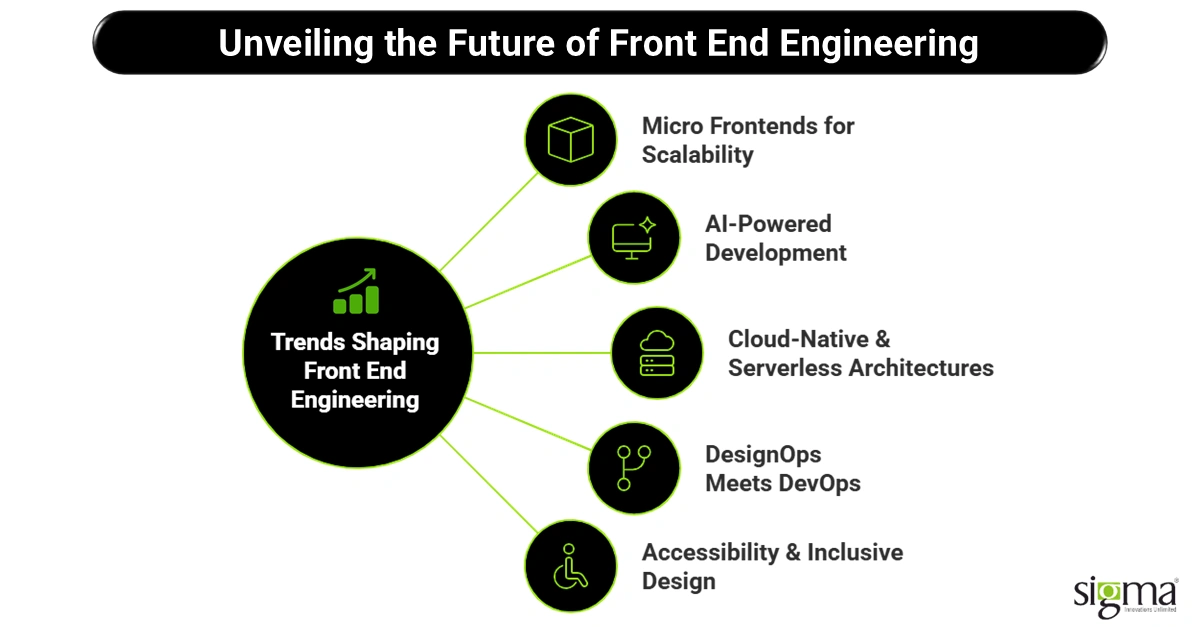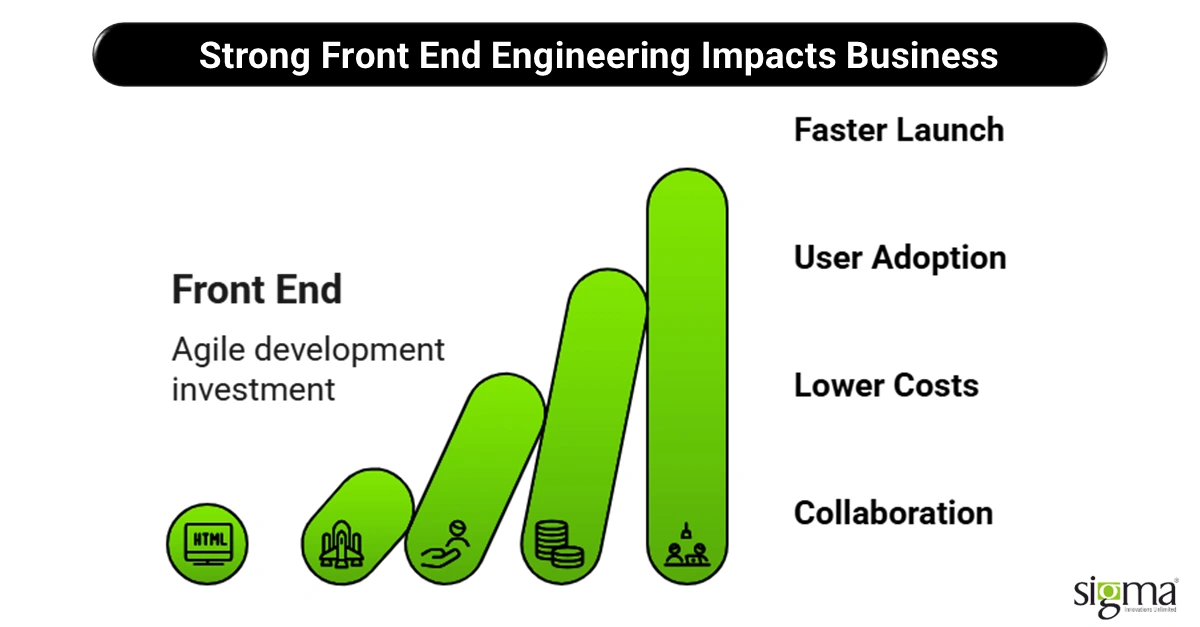Breaking Down Front End Engineering and Development for Agile Tech Projects
Key Takeaways:
- Front end engineering is the traffic light system for Agile. Without it, projects crash into delays and misalignment.
- Component-driven architecture is like Lego bricks. Reusable, modular parts make it easy to scale products without rebuilding the whole castle.
- Agile + automation = nitro boost. CI/CD pipelines and testing frameworks keep releases fast, smooth, and on track.
- Engineering is the foundation, Agile is the framework. Build the house right, and it can stand tall through endless renovations.
- Trends like AI, micro frontends, and cloud-native setups aren’t “nice-to-haves”—they’re the crystal ball into scalable digital success.
Customers expect fast, scalable, and user-friendly digital products that not only look great but also perform flawlessly. That’s where front end development becomes a game-changer. It’s no longer just about creating attractive interfaces—it’s about building seamless experiences that drive engagement and business growth.
For companies running on agile development, the front end engineering layer often turns into a sticking point. Teams may find their projects stalling due to misaligned goals, unclear roles, or a lack of focus on the engineering side of the front end. When this happens, even the best back end systems or agile workflows fail to deliver the value decision-makers expect. Imagine having a high-speed engine under the hood but clunky tires slowing the ride—that’s the reality of poorly executed front end design in agile projects.
This is where software product engineering services step in. By combining structured front end engineering with proven agile practices, businesses can streamline collaboration, accelerate time to market, and ensure their digital products are built to scale.
In this blog, we’ll break down the challenges companies face with front end development in agile projects and explore how expert-led product engineering services can bridge the gap—helping you deliver digital products that are not just functional, but future-ready.
Understanding the Role of Front End Engineering in Agile
When most people hear front end development, they think about building web pages or writing code for user interfaces. But front end engineering goes much deeper than that. It’s the practice of combining UX principles, scalable coding practices, and product performance strategies to ensure that digital products don’t just look good—they work flawlessly across devices, users, and traffic loads.

Think of it this way: if front end development is about painting the walls, front end engineering is about laying the foundation, wiring the power, and making sure the house can expand without cracking. It bridges the gap between user experience, business goals, and technical scalability.
This distinction becomes even more critical in agile development. Agile thrives on frequent iterations, rapid feedback, and continuous delivery. Without solid front end engineering, those cycles often get bogged down—teams end up reworking code, fixing performance issues, or patching design inconsistencies instead of moving forward. That’s why agile development services increasingly rely on engineering-focused practices rather than just surface-level design.
And here’s the trend: modern software product engineering services for the front end aren’t just about using ReactJS, Angular, or Vue. Today, companies are embracing design systems, performance optimization in front end, and scalable architectures that allow products to evolve without technical debt. From frontend in microservices architecture to enterprise-ready dashboards, the goal is to create an adaptable layer that keeps pace with business growth.
In short, front end engineering matters because it transforms agile workflows from “design-build-fix” cycles into “design-build-scale” momentum.
Why Agile Tech Projects Struggle Without Strong Front End Engineering
Agile promises speed, flexibility, and continuous delivery—but many teams discover that without strong front end engineering, those promises fall short. The issues usually start small but snowball quickly:

- Miscommunication between design, development, and business teams: Designers envision one thing, developers interpret another, and business leaders expect something else entirely. Without a shared engineering framework, this disconnect leads to rework and frustration.
- Rigid front end architecture: Agile thrives on change, but a fragile or poorly planned frontend architecture breaks under the weight of frequent iterations. What starts as a small sprint often turns into a major refactor.
- Poor user experience from rushed sprints: When teams are focused only on “getting it out,” corners are cut. The result? Products that technically work but deliver clunky or inconsistent front end design experiences.
- Fragmented toolsets: Using multiple frameworks, inconsistent coding styles, or ad-hoc libraries creates silos that slow down releases instead of speeding them up.
The impact of these problems is real: delayed launches, inconsistent user journeys, and rising costs to “fix” what should have been engineered right from the start. A study by BCG Consulting highlights a key challenge for businesses: nearly half of all companies are struggling with project management, with over 30% of their tech development projects suffering from delays or budget overruns. Similarly, The agile framework is far from obsolete. A new report reveals that a commanding 95% of professionals see it as highly relevant, with 58% prioritizing its adoption to improve their operations.
Without strong front end engineering, Agile projects often become a cycle of quick wins followed by longer setbacks. Instead of driving innovation, teams are stuck in a loop of rework, patches, and performance firefighting. And in industries like fintech, eCommerce, or SaaS—where speed and user experience are everything—those gaps can cost more than just time; they can mean lost revenue and reduced customer trust.
Also Read: Breaking Down Enterprise App Integration Services: How It All Connects
Breaking Down Agile + Front End Engineering Synergy
Agile and front end engineering may seem like two separate disciplines, but in reality, they’re tightly connected. Agile thrives on iteration, collaboration, and adaptability. Front end engineering makes those principles actionable by ensuring that every sprint delivers something functional, scalable, and user-ready. Let’s break it down:

1. Iteration in Agile → Componentized Front End Development.
Agile is built on short, repeatable cycles. Strong front end engineering supports this by breaking UI/UX into reusable, testable components. Instead of re-writing entire screens, teams can improve one button, a form field, or a navigation bar without disrupting the whole application. This allows agile teams to deliver visible progress in every sprint.
2. Collaboration in Agile → Shared Design Systems and Standards.
Agile emphasizes cross-functional collaboration, but when designers, developers, and product owners speak different “languages,” friction arises. A robust front end design system creates a shared vocabulary, enabling faster handoffs and fewer misunderstandings. Teams align better, and products move from design to development without losing their intended user experience.
3. Adaptability in Agile → Scalable Frontend Architecture.
Change is constant in Agile, and rigid code is its biggest enemy. Engineering practices like modular coding, performance optimization, and frontend in microservices architecture ensure that new features can be added without breaking existing functionality.
One key enabler here is CI/CD pipelines with automated front end testing. Instead of manually validating every design tweak or code update, automation ensures that changes move seamlessly from sprint planning to deployment, keeping the product stable while enabling speed.
Think of it this way: front end engineering is the foundation of the house—without it, Agile walls collapse. You can plan as many sprints (walls) as you want, but if the engineering layer (the foundation) is weak, the whole structure risks falling apart.
This synergy is why many organizations now turn to software product engineering services to strengthen their front end layer. By combining Agile workflows with engineering discipline, they achieve faster releases, fewer bugs, and products that scale with business growth. In industries like fintech or eCommerce—where speed and user experience are non-negotiable—this approach is the difference between a product that struggles and one that leads the market.
Solution Framework: Front End Engineering in Agile Projects
Solving Agile bottlenecks isn’t about adding more sprints or more people—it’s about engineering smarter. A strong front end engineering framework transforms Agile from “just shipping features” to building scalable, user-focused digital products. Here are the key pillars of success:
- Design-Development Integration: In too many Agile projects, UX and engineering run in parallel but rarely intersect. The fix? Bring them under one sprint framework. By aligning designers and engineers early, teams ensure that every iteration delivers not just functional code but user experiences that resonate.
- Component-Driven Architecture: Reusable, modular design systems are the backbone of modern front end development. Whether it’s ReactJS components or Hyvä Theme for Magento, this approach accelerates iteration while keeping quality intact. Teams can swap, update, or expand components without rewriting the entire product—a game-changer for scalability.
- Performance-First Mindset: Speed and accessibility aren’t afterthoughts—they’re requirements from Day 1. Adopting a performance optimization in front end approach means products load faster, handle scale better, and meet accessibility standards out of the box. This is especially critical in fintech apps and eCommerce platforms, where milliseconds directly impact revenue.
- Tooling & Automation: Agile thrives when manual work is minimized. CI/CD pipelines, automated front end testing frameworks, and analytics dashboards ensure every release is both fast and reliable. Real-time feedback loops let teams act quickly, reducing rework and costs.
At Sigma Infosolutions, our software product engineering services bring these pillars together. We integrate design and engineering into Agile sprints, leverage frontend architecture that scales with your business, and build automation pipelines that keep quality high while speeding up delivery. From enterprise eCommerce storefronts to secure fintech dashboards, our front end engineering approach helps businesses turn Agile into a competitive advantage.
When Agile principles meet engineering discipline, companies don’t just launch products—they launch products that last, scale, and perform.
Trends Shaping Front End Engineering in Agile
Front end engineering has evolved rapidly in the last few years, especially within agile development environments. What once focused mainly on UI coding has expanded into a discipline driving scalability, automation, and user-centric growth. Here are some of the biggest trends reshaping how enterprises approach front end development today:

- Micro Frontends for Scalability: Large enterprises are breaking down monolithic applications into micro frontends, where individual teams own and deploy parts of the interface independently. This modular approach mirrors Agile’s iterative nature and allows faster scaling.
- AI-Powered Development: From automated code generation to intelligent testing and personalized UI recommendations, AI is changing how front ends are built. For example, generative AI can draft UI components, while machine learning ensures faster bug detection. This not only shortens sprints but also improves accuracy.
- Cloud-Native & Serverless Architectures: Agile thrives on speed, and cloud-native front end setups reduce infrastructure bottlenecks. Serverless approaches let teams focus on user experience without worrying about scaling servers.
- DesignOps Meets DevOps: To deliver faster, design and development pipelines are converging. Front end engineering is at the center of this, using shared design systems, automated testing, and CI/CD workflows to ensure design intent translates directly into deployed code.
- Accessibility & Inclusive Design: With regulations tightening and user expectations rising, accessibility is no longer optional. Agile front end practices now embed inclusive design checks into every sprint, ensuring products work for all users from day one.
Together, these trends show that modern software product engineering services go far beyond frameworks like ReactJS or Angular. They combine frontend architecture, automation, AI, and design-first practices to deliver digital products that scale with the business. Enterprises that adopt these trends aren’t just keeping up with Agile—they’re setting the pace.
Also Read: Unlocking Business Growth with Agile Custom Development Services
Sigma Infosolutions’ Approach to Agile Front End Engineering
At Sigma Infosolutions, we see front end engineering as the bridge between brilliant ideas and market-ready digital products. Our software product engineering services are built to help businesses scale faster while eliminating the front end bottlenecks that often derail Agile projects.
Our expertise spans across industries and platforms:
- eCommerce solutions: We design and engineer powerful storefronts using Adobe Commerce (Magento), Shopify, WooCommerce, BigCommerce, and the high-performance Hyvä Theme—ensuring faster load times and better customer engagement.
- Fintech solutions: From building secure, compliant dashboards to integrating front end design with financial APIs, we help fintech leaders deliver apps where speed, accuracy, and trust matter most.
- Custom enterprise apps: Whether it’s ReactJS-based portals, .NET enterprise applications, or Salesforce-integrated platforms, we craft frontend architecture that adapts as business needs evolve.
So, how do we help businesses move past the front end roadblocks in Agile?
- Dedicated Agile Pods: We create pods of engineers, designers, and testers who focus exclusively on your product. This model accelerates delivery while keeping accountability high.
- Cross-Functional Collaboration: Our teams work under one sprint framework—UI/UX, developers, and QA engineers collaborate closely, ensuring designs aren’t just beautiful but technically scalable and test-ready.
- Scalable Frameworks & Best Practices: From modular ReactJS components to automation-driven CI/CD pipelines, we build systems that can scale without constant rework. Our agile development services ensure that each sprint delivers incremental value without losing sight of long-term product goals.
By combining Agile discipline with strong front end development, Sigma ensures that enterprises—from fast-moving startups to large global brands—launch products that are fast, scalable, and ready for the future.
Business Impact: What Companies Gain
When enterprises invest in strong front end engineering within their agile development framework, the payoff is significant:

- Faster Time-to-Market: Modular front end development combined with CI/CD automation means businesses can launch updates weeks—or even months—faster than traditional approaches.
- Better User Adoption: Intuitive, responsive interfaces keep customers engaged. A smooth front end design encourages higher adoption rates, whether it’s for a fintech app, an eCommerce storefront, or an enterprise dashboard.
- Lower Long-Term Costs: Reusable components and scalable frontend architecture reduce rework. Companies spend less time “fixing” code and more time innovating.
- Improved Collaboration: With a shared design-development framework, business leaders, designers, and engineers finally get on the same page—streamlining decision-making and reducing miscommunication.
And the results aren’t just theoretical. According to McKinsey, companies that embed engineering discipline into Agile cycles see faster product releases and higher team productivity. Imagine an Amazon-like retail app that predicts future demand with 90% accuracy, helping businesses optimize inventory, reduce stockouts, and boost sales by 15%. That speed translates directly into market advantage—especially in industries where being first is everything.
By aligning software product engineering services with Agile best practices, businesses don’t just release features—they release competitive advantages.
Let’s Engineer Agile Success Together
Agile is built for speed, but without strong front end engineering, projects often stall—bogged down by misaligned teams, fragile code, and user experiences that don’t hit the mark. The result? Delayed releases, higher costs, and lost opportunities.
At Sigma Infosolutions, we solve this challenge by combining front end engineering with end-to-end software product engineering services. From building modular, reusable components to creating scalable frontend architecture and embedding CI/CD automation, we ensure Agile projects don’t just move fast—they move smart. Whether it’s powering secure fintech apps, high-performing eCommerce storefronts, or custom enterprise platforms, our Agile pods deliver digital products designed to scale.
Now is the time to take your Agile strategy beyond process and into engineered execution. Let’s align your business vision with technical excellence and deliver products that are fast, intuitive, and future-ready.
Partner with Sigma Infosolutions today, NOW!
Schedule a consultation or discovery session with our experts and see how our Front End Engineering and Software Product Engineering Services can help you accelerate Agile success.


